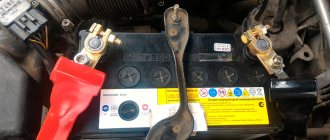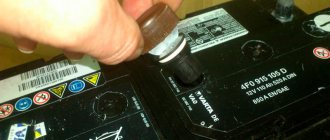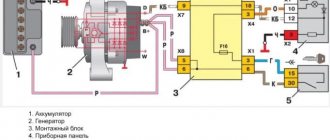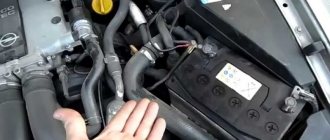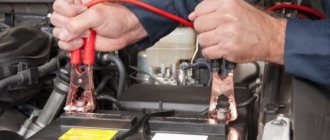It is a mistake to think that the battery in a car is needed to turn on music when the engine is not running and the generator does not supply power to consumers.
The battery's job is to start the power unit. Some people don't see anything difficult about it. And you ask your father or grandfather what it was like to manually turn the crankshaft using a crooked key to start the engine. This is the function that the battery actually performs.
It is difficult to overestimate the importance of the battery. Therefore, increased demands are placed on its selection, operation and maintenance. Sometimes it happens that traces of oxidation processes appear on the terminals. Some people don’t attach any importance to this, while others try to quickly find and eliminate the cause.
Why does battery terminals oxidize?
A poor connection between the wire tip and the power supply terminal leads to interruptions in the operation of the on-board equipment and problems when starting the car engine. The appearance of an oxide film on the terminals indicates a malfunction in the power supply. Even good contact oxidizes over time as a result of the interaction of metal surfaces with oxygen, and the use of different metals in the contact group can also be a reason.
If the battery terminal is oxidized, there must be a reason for it. Let's look at the most common ones:
- Vapors from evaporating electrolyte have a detrimental effect on the condition of the surface of the battery terminals. When interacting with oxygen, acid vapors become white.
- Poor contact switching in a humid environment can lead to oxidation in the microgaps between the tip on the wire and the power supply terminal. As a result of sparks jumping, the terminal becomes covered with black soot.
- During operation of the battery under conditions of high humidity, the copper contained in the terminal becomes covered with a greenish coating and traces of corrosion.
- When various metals are used in switching, a chemical interaction between these materials occurs and the battery tips can be covered with a film with a green tint.
Interesting to know! At different terminals of the power supply, oxidation occurs differently, which is due to differences in design.
What causes the positive terminal on the battery to oxidize?
In most cases, the positive terminal of the battery is covered with a cap, which can cause condensation to form underneath. If the integrity of the housing is compromised and electrolyte vapor leaks under the influence of elevated temperatures, acid particles accumulate under the terminal cover, which leads to oxidation.
However, covering the positive terminals with covers prevents dirt from getting in and sparking on the contacts, which can result in a short circuit and damage the power source. In most cases, a white coating is observed on such tips.
Why does the negative terminal of the battery oxidize?
The battery terminals with a negative charge are not protected, so vapor accumulation during leakage and moisture condensation does not occur. However, there is an increased chance of dirt and debris getting onto the metal-to-metal contact surface. Over time, sparks may occur during startup, which leads to chipping of the terminal and its subsequent blackening.
Contact is lost, the internal capacity of the power supply gradually decreases and ultimately leads to battery failure.
FAQ
What is the cause of oxidation of battery terminals?
First of all, this is a weak contact at the battery terminals or electrolyte entering the contacts from the ventilation ducts of the cans or through cracks in the case.
What are the dangers of oxidation of battery terminals?
Oxides do not pass current well, causing wires and contacts to heat up, the battery does not charge well, and the starter has difficulty cranking.
How to prevent oxidation of battery terminals?
Check the battery and contacts periodically. The body must be washed with a soda solution, the terminals must be tightened well, but not excessively, and then covered with a layer of special dielectric grease to protect them.
After cleaning, the battery terminals still oxidize heavily, what should I do?
This means that the cause of the corrosion was not found and corrected. Inspect the battery again, check the connections at the battery terminals, the reliability of the connection of the negative cable to ground, check for undercharging or overcharging.
What causes the appearance of oxides on the terminals
Gradually, in places where oxidation has appeared, the surface resistance on the contact groups increases. As a result, the accumulated battery charge loses most of its power to overcome it. In this case, starting the car engine becomes almost impossible, since the current strength is not enough to crank the starter.
The material on the battery contacts becomes chipped, while the switching area is reduced, which leads to a significant decrease in the conductivity of the metal. As a result of this phenomenon, the terminals will periodically become coated in the future even after cleaning.
Important! It is necessary to constantly carry out visual inspection and preventive cleaning of the terminals on the battery for better contact.
If a white coating appears from electrolyte evaporation as a result of microcracks in the housing, the power source itself must be replaced. Destruction of the case occurs during improper use of the battery, during shaking and shock. If electrolyte gets on parts and mechanisms if it leaks, it will damage some parts of the car.
If upon visual inspection a greenish tint is observed, then the battery is used in an environment with high humidity. High levels of humidity can lead to corrosion of metal parts and surfaces.
Why does plaque appear?
To prevent such phenomena, it is important to understand the reasons why car battery terminals oxidize.
Oxidation processes are almost inevitable for any parts made of metal if they are not provided with any protection or special protective coatings.
This can safely include the contact group of batteries for cars.
There are several reasons why the positive and negative terminals become heavily oxidized over time, which can lead to various malfunctions of the battery and the entire vehicle.
- Electrolyte. Electrolyte particles, that is, a mixture of sulfuric acid and distilled water, appear on the output terminals. Most often, the reason for the leak is trivial. These are plugs that are not screwed tightly enough and are used on serviceable batteries. But the presence of weakened rods or the occurrence of microcracks cannot be ruled out.
- Physical deterioration. Nevertheless, oxidation can rightly be considered a natural process. Therefore, it is rather a matter of time, even when there are no other factors. If the battery is old and has been in use for a long time, plaque will definitely appear. Therefore, the best solution would be to replace the battery.
- Change in electrolyte density. It is important to maintain batteries promptly and correctly. The idea is to renew the charge, as well as add electrolyte or simply distilled water. But many people dilute the acid with water themselves, often do not follow the proportions, and do not follow the manufacturer’s recommendations. As a result, the electrolyte poured into the jars does not meet the requirements. This may manifest itself in the form of plaque.
- Loss of contact. We are talking about the contact between the wire clamp and the terminals. Oxidation occurs because the contact group is exposed to water and electrolyte vapors. Gradually, due to the passage of current along the surface of the anode, the latter is destroyed. Microcracks appear and oxides accumulate there, expanding the geography of their presence over time.
If the problem is in service life, nothing can be done about natural wear and tear. You just have to dispose of the old battery and buy a new one in its place.
What are the signs to determine that terminal oxidation has begun?
The appearance of an oxide film and white coating on the contact group of the battery can be determined visually, as well as through indirect reasons. These include a decrease in the brightness of lighting devices, as well as a drop in the value of the maximum starting current when starting a vehicle.
During a visual inspection, it is necessary to monitor the appearance of microcracks, loose leads, as well as traces of electrolyte leakage and the appearance of dirt on the ventilation holes. If the battery charge is fully restored, but a significant drop in current occurs during startup, the cause must be sought in poor contact between the battery terminal and terminal.
To determine whether a white coating is a sign of electrolyte vapor leakage, it is necessary to remove the battery from the equipment. Subsequently, the contact group is wiped with a weak solution of soda and water. When interacting with alkali, the white coating on the battery terminals dissolves, releasing gas and heat.
Identifying the problem
Oxidation of battery contacts can be determined by a number of signs. These include the following:
- The starter does not engage immediately or it is very difficult to turn the crankshaft. The most important thing is to start repairing it right away, otherwise the car's electrical system may fail.
- Dimming of side lights and headlights can also be a result of oxidation of the battery terminals.
When thinking about what to do if the battery terminals are oxidizing, you need to remember that you need to solve the problem as soon as possible. If you neglect this, the car’s battery will become unusable, and you will have to spend money on a new device.
Cleaning the Battery Terminals
It is possible to clean the terminals from oxidation mechanically; for this you need to use a coarse cloth moistened with water, a brush with metal hair, and also an ordinary knife. Before cleaning, you should remove the battery from the vehicle so as not to damage or stain other mechanisms, and also for convenience. After handling the terminals, it is recommended to remove all dirt and debris from the surface of the power supply. Clean the ventilation holes; blocking the free exit of excess gases can have a detrimental effect on the battery terminals.
A mechanical battery terminal cleaner can come to the aid of motorists; it can remove minor manifestations of oxide films on the contacts. After cleaning has been completed, the power source is installed in its place, the contact group must be securely secured to the battery terminals. To prevent the terminal from oxidizing in the future, it is recommended to lubricate it with grease.
You can treat the contacts with ordinary lithol, but as a result, such a lubricant will only collect dirt, which in the future can lead to a malfunction of the power source.
Advice! If, after cleaning, oxidation of one of the terminals occurs again, you need to check the condition of the battery case.
What is the danger of oxidation?
The battery is a consumable item. Yes, the service life can be at least 3-4 years, and some are able to perform their duties for 6-8 years. But over time, the battery life ends due to natural reasons.
A significant reduction in service life can be caused by several factors:
- terminal oxidation;
- mechanical damage;
- depressurization and leakage of electrolyte;
- sulfation;
- increased self-discharge.
Oxidation is a full-fledged pathology, and most often this process affects inexpensive maintenance-free batteries.
Oxidation manifests itself in the form of a whitish coating that appears on the terminals.
The main threat is that contact between wires and terminals is broken. The consequences for the battery may vary. Heavily oxidized terminals contribute to the undercharging that occurs when the generator is running. It tries to supply power and charge the battery, but the battery cannot fully accept it.
Still oxidized contacts lead to the fact that even with a full charge, some consumers may not receive power. This usually manifests itself in the form of a decrease in the intensity of the glow of headlights, turn signals and other optics on the car.
If you notice that the crankshaft turns with great difficulty or the engine does not start as easily as before, you should look under the hood and check for oxides on the terminals.
Types of terminal lubricants
Before using various products, you need to know what beneficial properties they should have:
- acid protection;
- protection from wet environments;
- dielectric properties;
- increased viscosity, maintaining this property with increasing temperature;
- extended operating temperature range.
Many car enthusiasts have a question about how to lubricate the battery terminals so that they do not oxidize. There are several types of products that protect against oxidation during their use.
Silicone lubricants
It has high moisture-repellent properties over a wide range of operating temperatures. Manufacturers indicate increased fluidity as the only drawback.
Teflon products
They have high penetration when applied to terminals, but this ability can also be taken as a disadvantage. Manufactured using silicone components.
Oil lubricants
These products are produced on both a synthetic and mineral basis. The special additives used provide improved protection of surfaces from oxidation. Among the most common means it should be noted:
- grease;
- petrolatum;
- LIQUI MOLY KUPFER-SPRAY.
Greases
A distinctive feature of this lubricant is the use of special thickeners in the composition. Mineral oils are used as a basis.
Copper based lubricants
Reliably protects terminals from aggressive agents, high temperatures and dynamic loads. Has increased viscosity.
Wax products
They have tightness, high protective properties in case of breakdown and do not allow the appearance of stray discharges. Stays on the terminals for as long as possible.
What to do with sulfation of battery terminals?
It's more difficult here. First of all, because we have already found out that if there are sulfates, then there is acid. Without it, this reaction will not begin. And this, in turn, means that the electrolyte or its vapor somehow penetrates from the battery to the outside. In fact, he has several ways.
The most common case is the banal sloppiness of a car enthusiast. I loosened the battery plugs, measured the density, recharged (a master class on recharging Ca-Ca batteries before winter), added water, and so on. And at this time, drops of electrolyte settle on the battery body and, as a rule, on the terminals. All. The necessary components of the sulfation reaction are available.
The second path of acid to the terminals is through holes, which are designed for emergency release of electrolyte vapors when the battery is boiling. This happens for only one reason - overcharging. When boiling, even if there is no visible acid splash, there is vapor. They definitely settle on the terminals and condense. Again, all the components for a harmful chemical reaction are present.
The last way for the electrolyte to escape is through microcracks between the housing and the terminals. They appear when the battery often “twitches” to charge, that is, the terminals are constantly, and not always carefully, removed. Naturally, they become loose, and gaps form between them and the body.
The terminal has oxidized - what to do:
- Keep the battery case clean . Electrolyte accidentally splashed during maintenance can be safely removed using soda dissolved in water (be sure to rinse with plain water after baking soda). A simple rag. The acid will be neutralized by the alkali.
- Do not wash the battery with plain water from a well or tap . There are salts there. The water will evaporate from the body, but the salts will remain. Sooner or later, current will flow through them, and the self-discharge of the battery will increase. Use distilled water.
- If the battery is recharged from the generator, replace the relay regulator . The battery will stop constantly boiling, and electrolyte vapors will not reach the terminals. Plaque on the positive terminal will no longer appear. Read more about generator malfunctions here.
- Keep the battery more than 60% charged . If the battery is old, you don’t drive much, the relay regulator is acting up - use stationary chargers.
- If there is a suspicion that microscopic gaps have formed between the terminals and the housing, felt or felt gaskets help . You can either cut these yourself or buy them ready-made at a car store. The gaskets are lightly impregnated with oil or a special agent for treating battery terminals, and put on before installing the clamps. Their role is to absorb electrolyte leaking from the battery. Therefore, you should not hope that they will save you indefinitely.
Foreign gaskets for battery terminals
We usually cut them out of felt or felt.
If the battery is worn out or damaged, buy a new one as soon as possible. How to choose - read here. Oxidation and sulfation of terminals is not yet a fatal problem. But if the metal of the body is constantly coated with electrolyte, you will be able to see not only corrosion, but also entire through holes in the engine compartment.
How to apply lubricant, and where is it best to apply it?
To extend the life of the lubricant and protect the terminals from oxides, it is important to strictly follow the technology for applying protective compounds.
Here the algorithm of actions is as follows:
- Cleaning the surface of the terminal and nearby areas from contamination. This is required to reduce resistance to a minimum.
- Cleaning the terminals and putting them on the battery. Next, it remains to tighten the nut for maximum fixation.
- Treatment of the top and side of the tip and outlet. It is important not to miss anything here to avoid moisture getting on the surface.
Please note that it is recommended to process the entire node, and not just some specific elements.
It is worth remembering that lubricating the inside of the terminal before applying it to the battery is prohibited. Otherwise, it will not be possible to achieve high-quality contact, and the treatment itself will only cause harm.
How to Safely Clean Battery Terminals
This can be done using a regular soda solution : as you know, an alkaline medium is an antagonist of acid and dissolves it.
Here is a detailed algorithm for how to clean battery terminals using soda solution:
- Turn off the car engine.
- Loosen the nut and carefully remove the negative terminal.
- Then remove the positive one in the same way.
- Remove the battery from the car.
- Carry out a thorough inspection of it for cracks or leakage of liquid into the machine . If everything is serious, the battery needs to be changed urgently, and it can no longer be cleaned.
- Check the wiring for defects and possible breaks , insulate or replace weak ones if necessary.
- Prepare a soda solution in advance - one tablespoon of soda per glass of warm water.
- Wear rubber gloves to protect your hands.
- Use an old toothbrush.
- Soak it in soda and first treat the terminal from above.
- You can simply place the battery cables in hot water , this will help remove corrosion.
- Carefully, with little effort, clean all elements from the acid layer and corrosion using a brush, dipping it in a soda solution.
- Rinse the battery carefully using cold water..
- Wipe everything with a clean dry cloth.
- Treat the terminals with protective lubricant.
- Connect the positive terminal back to the positive terminal of the battery.
- Do the same with the negative terminal.
- Processing is complete - finally, make sure that everything is securely fastened.
This is interesting: Renata 371 battery: characteristics and analogues
If the plaque is very strong and the soda solution does not help, all that remains is to use sandpaper and a sharp knife - of course, everything should be done as carefully as possible.
What lubricants are suitable for winter?
To protect the terminals from oxidation in cold weather, the use of special compounds is recommended.
The most popular ones include:
- Molykote HSC Plus
- a composition that is intended for FIAMM series batteries, but can also be used for other devices. The advantages are high electrical conductivity and the ability to operate in a wide temperature range (-30...+1100 degrees Celsius). - Cyatim
is an affordable option. Its main disadvantage is low conductivity. - Spray cleaners
. In this series, products from the following manufacturers are in demand - Hi-Gear, SVITOL and others. It is based on purified oil, which, once it hits the surface, “squeezes out” moisture and provides a reliable protective film layer. The latter protects the surface from oxidative processes and the appearance of dirt. The main disadvantage is the short-term effect of the composition. - Grease-type lubricants (options: LIQUI MOLY, Gunk)
. In structure, these are thick compositions that have the appearance of a cream and also have an oil base. Their advantage lies in the ease of application, because you don’t have to worry about getting the composition where it’s not needed. In addition, the lubricant stays on the surface longer and cannot be washed off with shampoo. That is why many craftsmen recommend choosing just such products for winter processing.
